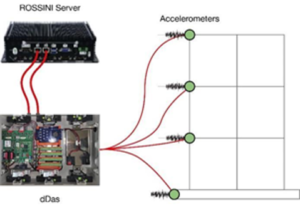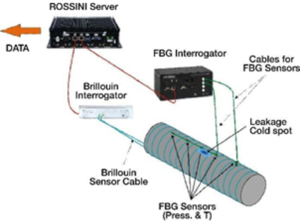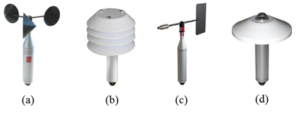The ROSSINI platform integrates two different risk identification and evaluation methods: structural and environmental. The structural RIE is based on assessing structural damage of buildings and several plant components, such as pipelines, vessels and tanks. The environmental RIE instead results from estimating concentrations of chemicals in the entire industrial plant due to leakage from any plant component and simulating its spatial diffusion over time.
The collection of the input data for the two RIEs is carried out through the ROSSINI platform. This acquires and analyzes data from different sensor technologies, including Micro-Electro-Mechanical-System (MEMS) accelerometers, fibre-optic sensors (e.g., Fiber Bragg Grating, FBG, and distributed backscattering based) and a weather station, which are described below.
Accelerometers (MEMS)
Triaxial MEMS accelerometers are used for rapidly evaluating possible structural damage and providing input data to the structural RIE. Specifically, one accelerometer per floor is connected to a dynamic data acquisition system (dDas) to monitor dangerous peak accelerations and to periodically record environmental vibrations data useful for the identification of structural dynamics parameters as shown. The dDas acquisition system comprises a standalone acquisition board capable of acquiring, filtering and processing up to 32 simultaneous analogue channels with 24bit precision analogue to digital converters (ADCs). This module features sample rates up to 1kHz for dynamic acquisitions or periods from 1sec to 24hrs for static acquisitions.
Fibre optic sensors
The use of fibre optic (FO) sensor technologies in engineering and industrial applications has been significantly increasing. This is largely due to the several advantages they hold with respect to traditional sensors, such as immunity to electromagnetic fields, high sensitivity, good embeddability, lightweight and durability, and the capability of covering wide areas.
In the Oil & Gas industry, FO sensors have found widespread application in down-well temperature measurements, the structural monitoring of oil rigs, and the detection and security monitoring of potential pipeline leakages. Given the notable potentialities of FO sensors, both Fiber Bragg Grating (FBG) and Brillouin backscattering distributed sensors are used in the ROSSINI Project to collect and provide emission data necessary for the environmental RIE.
FBG sensors are point sensors available for a wide range of measurements, which can be used to build a large sensing network and which can be repeatedly queried at high frequency. Brillouin distributed systems exploit the full length of an optical fibre as a strain and temperature sensor and, consequently, they are quite suitable for pipeline monitoring.

Considering that gas leakages from pressurized vessels or pipes imply depressurization along with temperature drop, both pressure and temperature are monitored to detect possible gas releases into the environment. Specifically, FBG point sensors will be used to measure localized pressure and temperature variations at specific locations of the test vessel tested as part of the ROSSINI project. Distributed Brillouin sensors will also be employed for measuring temperature variations on a wide area of the surface of the same test vessel. Both types of sensors need to be connected to specific interrogation units through standard optical cables and connectors. The interrogation units are then connected to the ROSSINI server, capable of gathering data locally and sharing information throughout the online platform developed within the ROSSINI Project.
Weather station
A weather station is also used to provide meteorological input data for environmental RIE. The weather station is equipped with a wind speed sensor (a), a thermogravimetric sensor (b), in addition to a wind direction (c) and a solar radiation sensor (d), shown below.

Data acquisition system
The data acquisition system includes a set of several sensors installed in the environment, distributed processing units (called data acquisition board), and a data integration and filtering module running on the ROSSINI server in which robustness and redundancy have been considered of paramount importance during the design phase. In the field of data acquisition, the novelty introduced by the ROSSINI system lays in the possibility to exploit different sensor technologies (i.e., MEMS accelerometers, fibre optic sensors and weather station) depending on the specific plant’s needs and strategies agreed with the plant ownership. The entire hardware architecture is designed to be robust and redundant to problems that can occur during earthquakes or serious damages to facilities which can compromise the safety and correct functionality of the monitoring and alerting system. To ensure proper functioning in case of failure of the electrical system, the acquisition board is equipped with a battery that guarantees 12 hours of service and a solar panel to recharge it during the day. Also, the board electronics are suitably protected from accidental shocks or falling rubble by a rigid plastic box, allowing the system to operate in adverse conditions and harsh environments. The acquisition board supports wired gigabit connection to the local area network and wireless 4G/LTE modem. The physical connection is the most reliable and efficient one available and it is used as a principal connection, whereas the wireless one is used as a fail-safe option. Although secondary, the wireless connection allows for sharing real-time data to the ROSSINI server with minimum latency.